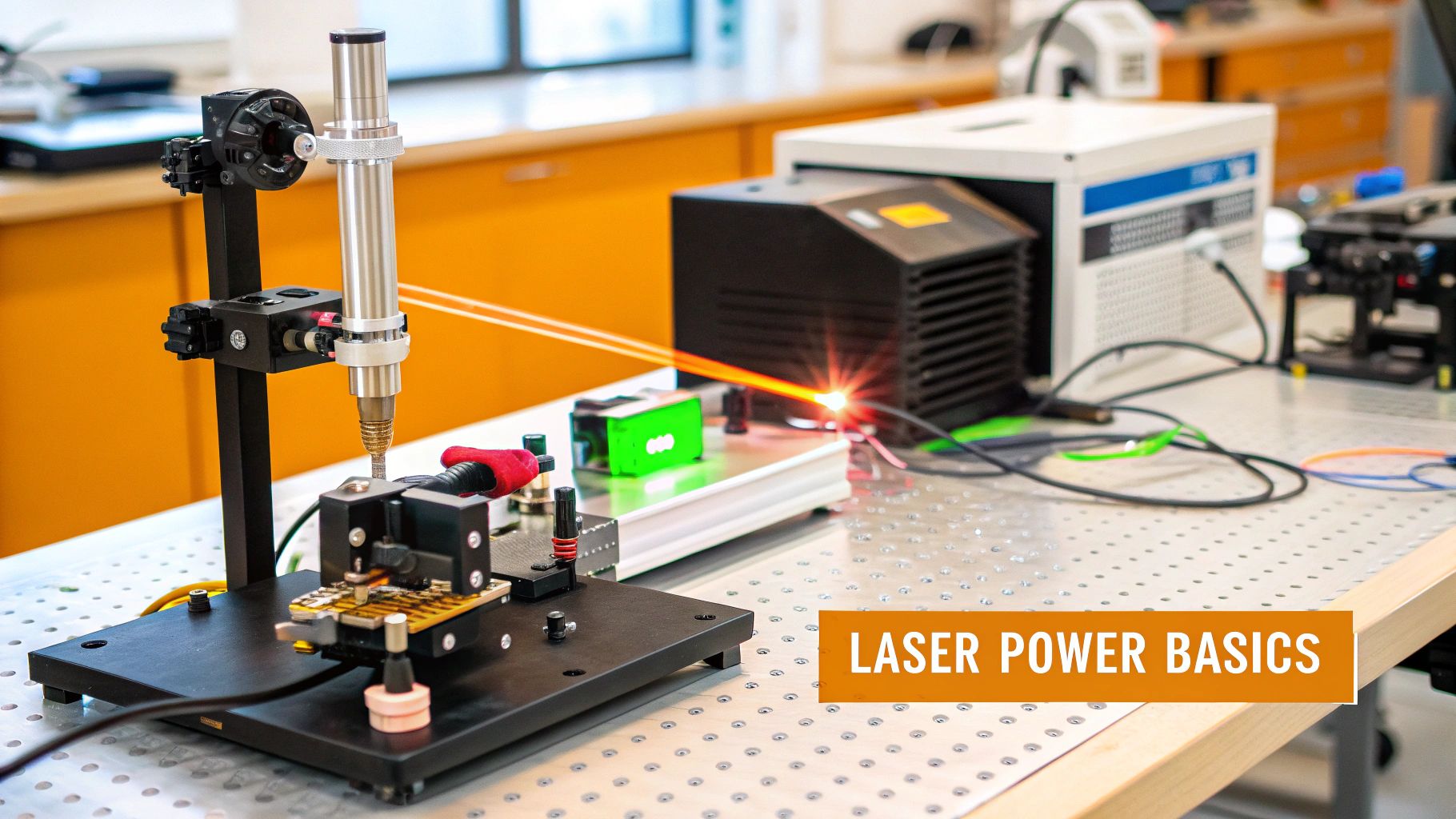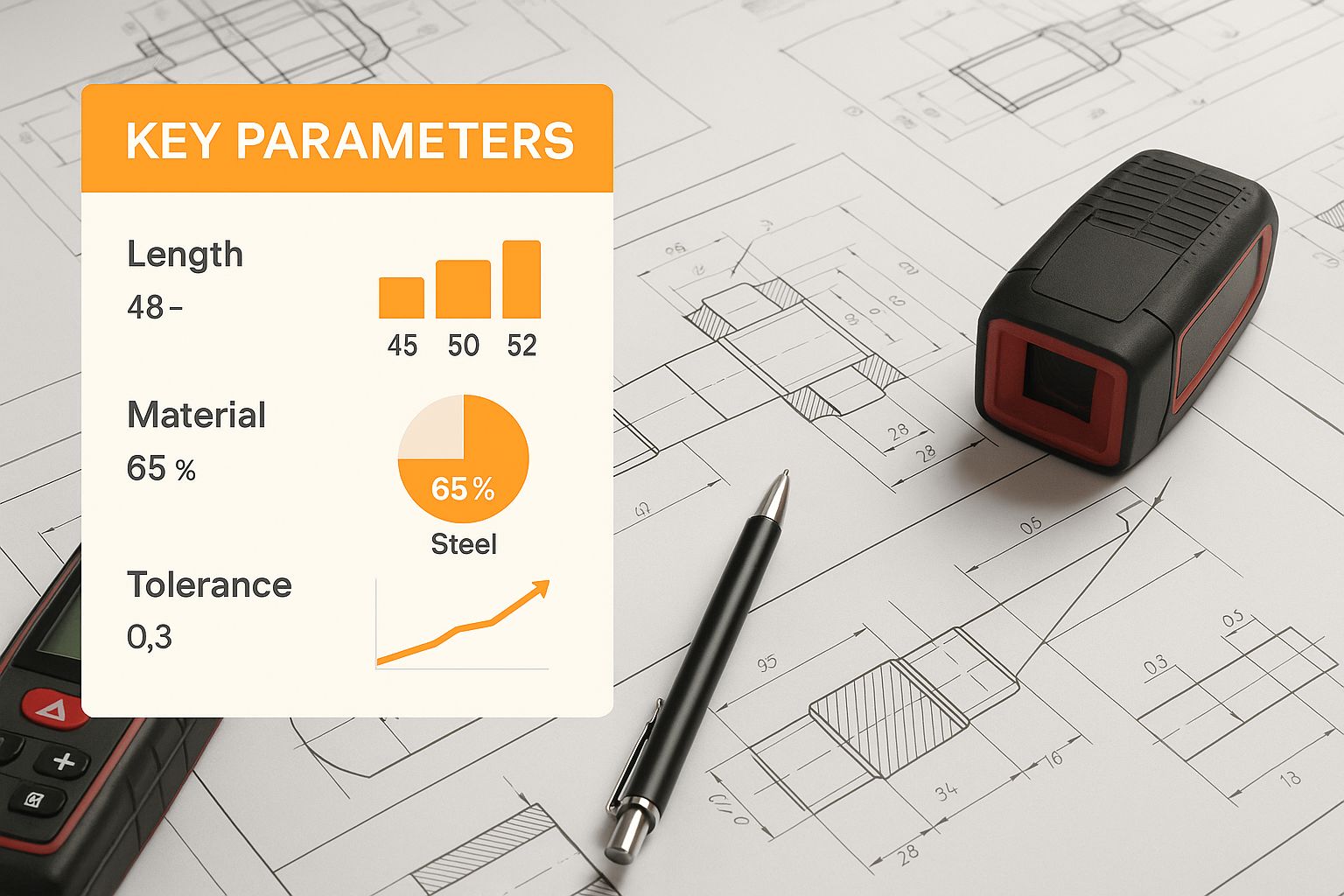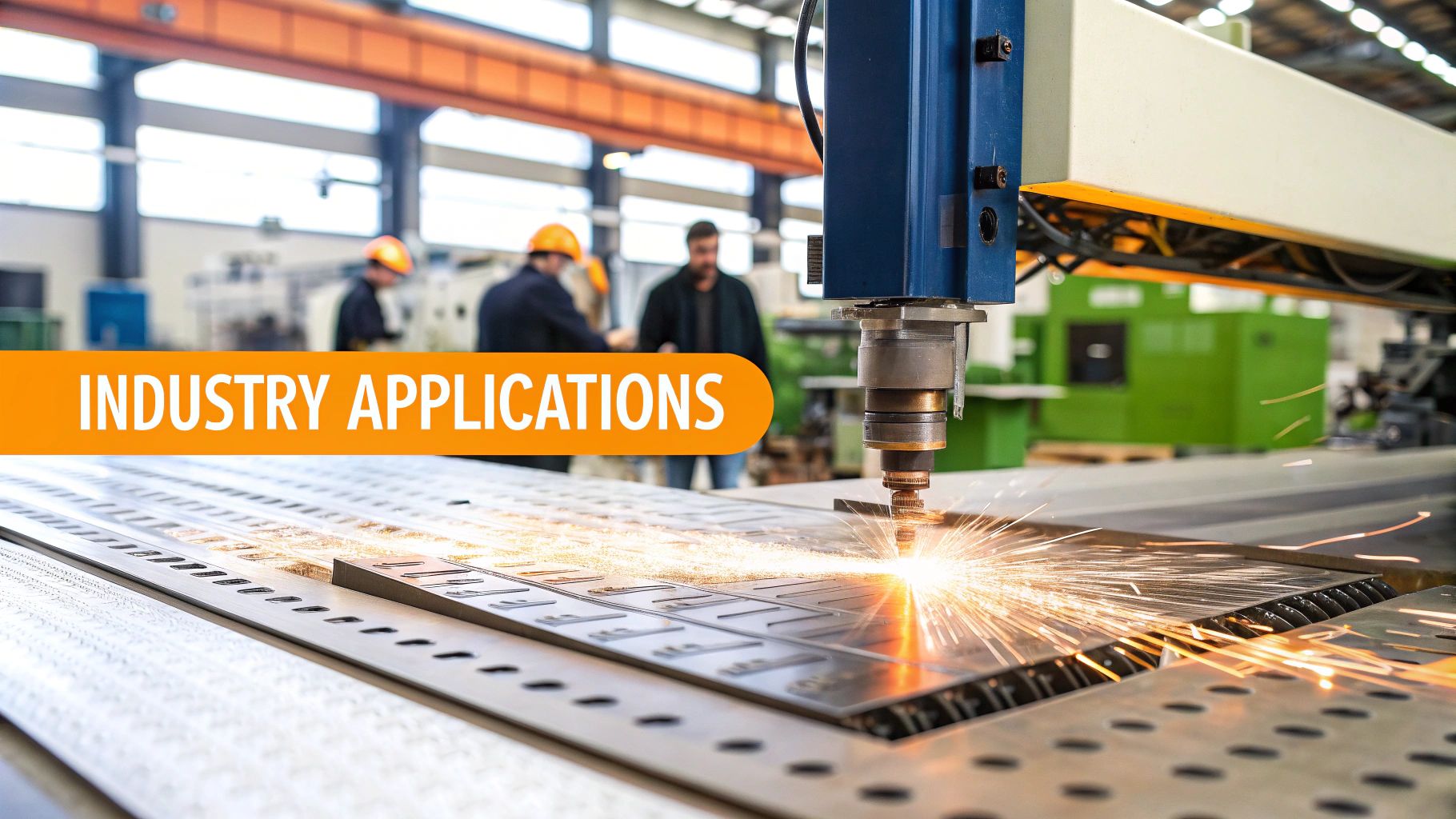The Science Behind Laser Power Calculators

Laser power calculators break down complex optical physics into actionable figures by measuring key parameters such as average power, peak power, and pulse energy. Average power reflects a laser’s continuous output, while peak power shows its highest intensity during a pulse. These values let engineers predict how a beam will interact with materials—from cutting steel to delicate medical procedures. Understanding these calculations is essential for both performance and safety.
Fundamental Laser Power Parameters
When you open a laser power calculator, it will typically ask for:
- Average Power: Energy output per second, in watts (W).
- Peak Power: Highest power in a single pulse, often much higher than average.
- Pulse Energy: Energy contained in each pulse, measured in joules (J).
These basics feed into advanced metrics like power density and fluence. You’ll also choose the right method depending on whether you have a continuous-wave or pulsed system. Accurate input ensures trustworthy results.
How Precision Shapes Results
Even a 1% measurement error can lead to serious defects or safety risks.
- In aerospace manufacturing, an underpowered beam may leave welds incomplete.
- In medical imaging, an overpowered pulse could damage tissue.
Optical engineers emphasize the importance of calibration and factors such as beam uniformity. Attention to detail guarantees repeatable results across both industrial and clinical applications.
Digital Tools Through the Years
Laser calculations once relied on slide rules and spreadsheets. A major shift came with web-based calculators from Ophir Optronics and Gentec-EO, making beam analysis faster for researchers and technicians. For example, the Ophir Optronics Laser Peak Power Calculator adapts to different beam profiles and offers instant safety-margin checks.
Over time, these platforms added algorithms to handle:
- Gaussian and tophat beam shapes
- Repetition rates
- Pulse widths
This evolution turned simple formulas into interactive digital tools.
Traditional vs Web-Based Calculators
| Feature | Basic Calculator | Modern Web-Based Calculator |
|---|---|---|
| User Interface | Command-line or spreadsheet | Interactive web form |
| Beam Profile Support | Limited (ideal beam only) | Multiple profiles (Gaussian, tophat) |
| Parameter Complexity | Average power only | Peak power, fluence, density |
| Real-Time Feedback | No | Yes |
| Accessibility | Local software | Anywhere with internet access |
By grasping the science behind laser power calculators, you can fine-tune beam settings and cut down on guesswork. Mastering these basics leads to smarter, safer laser use.
Mastering Critical Laser Power Calculations

This data chart visualizes peak power, average power density, and energy density (fluence) metrics alongside their effects on precision and process yield.
Moving from basic outputs to specialized metrics unlocks higher performance and safety margins. For example, peak power determines the maximum intensity of a pulsed laser, while energy density (fluence) indicates how much energy hits a surface area. Understanding these differences is vital when tolerances tighten to within ±2% in high-precision operations.
Key Laser Power Metrics For Specialized Applications
When choosing a calculation approach, consider:
- Peak Power: Highest wattage in a single pulse (key for ablation and cutting).
- Average Power Density: Continuous energy per square centimeter (critical in welding).
- Energy Density (Fluence): Joules per cm² (essential in medical and semiconductor processing).
The data chart shows that focusing on fluence calculations can boost microfabrication yield by up to 12% compared to more variable peak power methods.
Interpreting The Data Chart
The bar chart highlights:
- Peak Power methods deliver 5–8% higher variability if pulse shape isn’t accounted for.
- Average Power calculations remain within ±3% for continuous-wave lasers.
- Fluence measurements reduce surface damage incidents by 15% in plating applications.
These trends demonstrate that selecting the right metric can cut rework rates significantly.
Comparison Of Laser Power Calculation Methods
This table compares different laser power calculation methods, their applications, required parameters, and typical use cases to help readers determine which approach best suits their needs.
| Calculation Type | Required Parameters | Typical Applications | Accuracy Considerations | Example Formula |
|---|---|---|---|---|
| Peak Power | Pulse Energy, Pulse Width | Laser Cutting, Micromachining | Sensitive to pulse shape errors | P_peak = E_pulse / τ |
| Average Power | Energy per Second | Welding, Engraving | Best for CW, less accurate in pulsed | P_avg = E_total / t_total |
| Energy Density (Fluence) | Energy, Beam Area | Medical Ablation, Photolithography | Uniform beam profile required | F = E_pulse / A |
These comparisons underscore how each method varies in required inputs and accuracy, helping you choose the right calculation for your application.
Practical Approaches For Pulsed Vs Continuous-Wave Systems
In pulsed setups, calculate peak power first and then derive fluence to predict material response. Continuous-wave systems rely on average power density to maintain thermal equilibrium. Adjust formulas based on:
- Repetition rate
- Beam uniformity
- Pulse width versus exposure time
Avoiding Common Pitfalls
Even seasoned engineers can stumble over:
- Ignoring non-uniform beam profiles
- Overlooking sensor response times
- Mixing units (e.g., mm² vs. cm²)
- Relying on single-shot readings instead of long-term averages
Following these best practices helps you sidestep costly errors.
You might be interested in our guide on Optimizing Laser Equipment Selection for more on matching calculations to your hardware.
For clear procedure writing, see Code Documentation Best Practices.
Finding Your Perfect Laser Power Calculator
After mastering the theory behind peak power and fluence, it’s time to pick a practical online calculator that matches your needs. Web-based options differ in their features, interface, and supported beam profiles. Below, we review top offerings from Ophir Optronics, Coherent, and Gentec-EO. We’ll also walk through a sample calculation and help you find the right tool for your project.
Top Web-Based Laser Power Calculators
Here’s a snapshot of the leading free and commercial tools:
-
Ophir Optronics Laser Peak Power Calculator
• Supports Gaussian and Tophat beams
• Instant safety-margin checks
• Adjustable units in W, mW, and μJ -
Coherent Laser Power And Energy Calculator
• Intuitive interface with live graphs
• Handles CW, pulsed, and burst modes
• Exportable reports in PDF and CSV -
Gentec-EO Average Power Density Calculator
• Converts energy per pulse into power density
• Ideal for semiconductor and medical uses
• Mobile-friendly design
Feature Comparison Of Leading Tools
| Calculator | Key Features | Beam Profiles | Pricing | Notable Applications |
|---|---|---|---|---|
| Ophir Laser Peak Power | Pulse width, safety margin, multi-units | Gaussian, Tophat | Free | Micromachining, research labs |
| Coherent Power & Energy | Real-time graphs, batch processing | CW, Pulsed | Free/Paid | Fiber welding, materials testing |
| Gentec-EO Power Density | Energy-to-density conversion, API access | 1/e², Flat-Top | Free | Semiconductor, medical imaging |
Each calculator brings distinct strengths. For instance, Ophir’s tool excels at detailed safety checks, while Gentec-EO shines with clear density conversions.
Step-By-Step Calculator Walkthrough
To show how it works, here’s a typical Gentec-EO workflow:
- Select Laser Beam Type (Gaussian or Flat-Top)
- Enter beam Diameter (mm) and Repetition Rate
- Input Energy per Pulse or Average Power
- Click Calculate to view Power Density (W/cm²)
Once you’re familiar with the fields, this process takes under a minute. Consistent units and the right beam type are crucial for accurate results.
Choosing The Right Tool For Your Application
If you’re focused on semiconductor fabrication, precise density outputs are essential for uniform etching. In fact, Gentec-EO calculators helped reduce production errors by 20% between 2015 and 2020 thanks to reliable average power density conversions. Explore more insights into power density calculations here. For high-speed micromachining, however, Ophir’s peak power functions may be more relevant.
Tips For Validating Digital Results
- Always cross-check against a calibrated power meter
- Run multiple trials to average sensor noise
- Compare units (W/cm² vs. J/cm²) before drawing conclusions
- Review sensor response time settings
Pairing a solid calculator with real measurements ensures reliable, repeatable laser power data—whether you’re in research, manufacturing, or medical imaging.
Transforming Manufacturing With Laser Calculations
Manufacturing engineers rely on laser power calculators to improve product quality and reduce material waste. These tools convert raw beam parameters into clear targets, ensuring consistent welds, etches, and cuts on fast-moving assembly lines. Automotive part suppliers, for instance, have seen defect rates fall sharply by adding routine power checks at each station. Production teams can then optimize throughput without losing accuracy.
The global demand for laser power calculators now reflects trends in precision fields—like calculating intraocular lens (IOL) power in laser refractive surgery using formulas such as Barrett True-K no history. Research shows that exact power computation is vital for both vision outcomes and industrial consistency; in 2022, over 80% of major manufacturers reported using advanced laser measurement tools to meet quality standards. Read the full research here. As a result, medical-grade optics protocols are shaping power-management routines on factory floors.
Real-World Case Studies
Across industries, teams deploy laser calculation methods to tackle production hurdles:
- Automotive Welding Plants: Daily calibration routines boosted weld integrity by 25%, cutting rework costs.
- Semiconductor Fabrication: Power density calculators achieved uniform etch depths, raising yield by 18%.
- Materials Processing Facilities: Real-time power monitors adjusted for temperature drift, reducing scrap by 30%.
| Sector | Quality Gain | Throughput Increase | Primary Challenge |
|---|---|---|---|
| Automotive Welding | +25% | +15% | Weld consistency |
| Semiconductor Etching | +18% | +12% | Uniform feature sizes |
| Additive Manufacturing | +22% | +20% | Layer adhesion |
Addressing Line-To-Line Variability
Standardized controls keep beam characteristics steady across multiple lines:
- Set fixed calibration intervals with traceable power meters
- Enable automated feedback loops tied to sensor readings
- Conduct cross-line benchmarking to catch drift early
- Train staff on unit consistency (W/cm² vs. J/cm²)
Together, these measures maintain each line within ±2% of target power, minimizing batch-to-batch variation.
Key Protocols For Quality And Throughput
To scale precise laser operations, plant managers follow these calculation steps:
- Schedule preventive maintenance alongside power calibration
- Install in-situ power sensors for live intensity adjustments
- Cross-validate digital outputs with physical meter readings
- Document calculation steps clearly to aid troubleshooting
Implementing these protocols cuts downtime and ensures every task runs under optimal beam conditions.
Best Practices And Tips
For sustainable improvements, keep these guidelines in mind:
- Always use uniform units when inputting parameters
- Maintain a calibration log to monitor sensor performance
- Consult equipment OEMs for recommended safety margins
- Automate alerts when power deviates beyond preset thresholds
Following these best practices ensures your laser processes deliver consistent, high-quality results every cycle.
Laser Power Precision In Medicine And Research
Precise laser dosing can be a matter of life and death in clinical settings. A 1% variation in power output may shift treatment outcomes from success to complication. Ophthalmologists rely on exact energy delivery to reshape corneas without introducing aberrations, while dermatologists set fluence levels to remove lesions without harming healthy tissue. A laser power calculator is essential for clinicians and research teams focused on photonics.
Medical Applications And Safety Margins
Clinicians use power calculators to map out safe ranges and fine-tune protocols.
- Refractive Eye Surgery: Predicting ablation depth within ±0.02 μm avoids over- or under-correction.
- Dermatological Procedures: Setting fluence between 5–20 J/cm² targets lesions while sparing adjacent skin.
- Minimally Invasive Surgery: Adjusting energy per pulse prevents thermal injury during endoscopic work.
These scenarios highlight why precise calculation is critical.
Laser Power Requirements Across Medical Applications
Table: Laser Power Requirements Across Medical Applications
This table outlines different medical procedures, their specific laser power requirements, calculation considerations, and safety margins to illustrate the critical importance of accurate calculations in medical settings.
| Medical Procedure | Power Range Required | Critical Parameters | Safety Thresholds | Calculation Method |
|---|---|---|---|---|
| Laser Refractive Surgery | 0.5–2 W average | Pulse energy, spot size | ± 0.02 μm ablation | Fluence = E_pulse / Area |
| Dermatological Lesion Removal | 5–20 J/cm² | Beam diameter, repetition rate | Max ΔT < 5 °C | Power Density = P_avg / Beam Area |
| Endovascular Laser Ablation | 10–60 J/pulse | Pulse width, peak power | Max tissue temperature | P_peak = E_pulse / τ |
In this overview, you can see how each procedure demands specific settings and safety margins. Accurate calculations ensure patient safety and optimal results.
Role Of Laser Power Calculator In Treatment Planning
A dedicated calculator speeds up protocol development by translating raw beam data into patient-ready instructions.
- Computes average and peak power using beam profiles
- Issues alerts when thresholds approach unsafe limits
- Converts units between W, J/cm², and μJ automatically
These functions minimize manual errors and maintain compliance with clinical standards.
Ensuring Reproducibility In Research
In research labs, consistent laser dosing is vital for valid results and publications.
- Photonic Materials: Regulating fluence to shape bandgap properties
- Cellular Photostimulation: Controlling average power to prevent phototoxic effects
- Nanofabrication: Coordinating peak power and pulse width for uniform etching
By applying a laser power calculator, researchers uphold both safety and scientific rigor.
You might be interested in: Mastering Laser Power Calculation for Medical and Research Use
Accurate power computation not only boosts patient outcomes but also drives new advances in photonics. Integrating a reliable laser power calculator across workflows guarantees safety and repeatability in the clinic and the lab alike.
DIY Laser Power Mastery: Formulas That Work

High-end power meters can be hard to access, but a simple laser power calculator method using common lab instruments can still provide reliable measurements. By tracking energy deposition or timing pulses, you can determine both average and peak power with around ±5% accuracy.
Below, we outline formulas for continuous-wave, pulsed, and Q-switched lasers. You’ll also find common pitfalls and step-by-step examples to guide your DIY measurements.
Continuous-Wave Laser Power Calculation
Continuous-wave (CW) lasers deliver a steady beam, so the focus is on average power.
- Formula: P_avg = E_total ÷ t
• P_avg is average power (W)
• E_total is energy in joules (J)
• t is exposure time in seconds (s)
For example, heating a small aluminum block (m = 0.05 kg, c = 900 J/kg·K) by ΔT = 10 K over 20 s yields:
E_total = m · c · ΔT = 0.05 · 900 · 10 = 450 J,
so P_avg = 450 J ÷ 20 s = 22.5 W.
A consistent temperature rise ensures your setup is ready for pulse measurements.
Pulsed Laser Peak Power And Fluence
Pulsed lasers deliver energy in brief bursts. To find peak power and fluence:
- P_peak = E_pulse ÷ τ
- Fluence (F) = E_pulse ÷ A
Where:
- E_pulse is pulse energy (J)
- τ is pulse duration (s)
- A is beam area (cm²)
For instance, a pulse of 0.2 mJ (0.0002 J) over 10 ns (10×10⁻⁹ s) gives:
P_peak = 0.0002 J ÷ 10×10⁻⁹ s = 20 kW.
With a beam diameter of 2 mm (A ≈ 0.0314 cm²),
F = 0.0002 J ÷ 0.0314 cm² = 6.37 mJ/cm².
Basic timing and spot-size measurements can rival costlier systems.
Q-Switched Laser Calculations
Q-switched lasers produce very high peaks at low duty cycles. Use:
- P_peak (Q) = E_pulse ÷ τ
- P_avg = P_peak × τ × f_rep
Where f_rep is repetition rate (Hz).
Example: E_pulse = 1 mJ, τ = 50 ns, f_rep = 1 kHz.
- P_peak = 0.001 J ÷ 50×10⁻⁹ s = 20 kW
- P_avg = 20 kW × 50×10⁻⁹ s × 1000 Hz = 1 W
Calculating both peak and average values helps pick the right settings for processing or medical tasks.
Common Calculation Mistakes
- Unit mix-ups: mm² vs. cm² can cause 100× errors
- Ignoring beam shape: treating a Gaussian beam as a tophat may overestimate density by up to 15%
- Sensor delay: photodiode rise time can skew τ readings
- Single-shot reliance: averaging multiple pulses smooths out random noise
Formula Comparison Table
| Laser Type | Key Formula | Variables Required | Typical Accuracy |
|---|---|---|---|
| Continuous-Wave | P_avg = E_total ÷ t | m, c, ΔT, t | ±5% |
| Pulsed | P_peak = E_pulse ÷ τ F = E_pulse ÷ A |
E_pulse, τ, beam diameter | ±7% |
| Q-Switched | P_peak = E_pulse ÷ τ P_avg = P_peak·τ·f_rep |
τ, f_rep, E_pulse | ±10% |
Mastering these formulas turns a simple laser power calculator method into a trustworthy measurement technique. Next, we’ll look at how to cross-check DIY results against calibrated meters for tighter tolerances.
The Future of Laser Power Calculation Technology
Laser measurement methods have grown more advanced, and the coming years promise higher accuracy across applications. Engineers will see tools that deliver faster, smarter, and more adaptable power calculations. These systems won’t just report numbers—they’ll offer insights and reduce manual tuning.
AI And Machine Learning In Power Calculations
AI-driven algorithms can analyze complex beam profiles and suggest optimal power settings within seconds. Neural networks trained on thousands of test cases can cut calculation time by up to 60%. As models ingest new measurements, they refine their predictions, improving accuracy with each cycle. Future calculators will flag anomalies and recommend corrective actions automatically.
Real-Time Monitoring And Cloud Integration
Cloud platforms are turning static meters into interactive dashboards.
- Real-time power monitoring systems upload sensor data instantly
- Remote calibration tools sync devices across locations
- Predictive maintenance alerts catch drift before it affects quality
These capabilities rely on secure data pipelines and strong encryption to protect sensitive measurements. Operators gain continuous visibility into beam stability, keeping output within ±1% of targets.
Miniaturization And Portable Solutions
Advances in photonics and microelectronics are shrinking laser power meters to handheld sizes.
- Compact sensors fit into field-testing kits
- Battery-powered units deliver 24-hour autonomous operation
- Bluetooth and Wi-Fi enable real-time reporting to mobile apps
With built-in calculators, portable meters let engineers check power density right on the factory floor. This mobility simplifies diagnostics in remote or harsh environments where bench instruments aren’t practical.
Next-Gen Photonic Integrated Circuits And Quantum Sensors
Looking ahead, photonic integrated circuits (PICs) and quantum sensors will raise sensitivity to new levels. Compare these advances:
| Technology Type | Main Strength | Typical Sensitivity | Deployment Timeline |
|---|---|---|---|
| AI-Enhanced Algorithms | Self-optimizing calculations | ±0.5% power accuracy | Already in use |
| Photonic Integrated Circuits | On-chip beam analysis | 10⁻³ W resolution | 2–3 years |
| Quantum Power Sensors | Single-photon detection | 10⁻⁶ W resolution | 3–5 years |
Understanding these options helps engineers plan upgrades that fit long-term goals. Explore our articles on emerging laser applications: Emerging Laser Technologies Collection.
Choosing the right mix of AI, cloud tools, portable meters, and advanced sensors will boost reliability and productivity. Stay current with expert interviews, technical guides, and market analysis at Laser Insights China.

